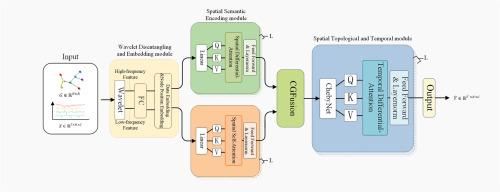基于小波解纠缠和拓扑语义神经网络的交通流预测
IF 8
2区 计算机科学
Q1 AUTOMATION & CONTROL SYSTEMS
Engineering Applications of Artificial Intelligence
Pub Date : 2025-06-04
DOI:10.1016/j.engappai.2025.111367
引用次数: 0
摘要
现有的时空模型难以捕捉交通流中既涉及局部拓扑结构又涉及多种因素形成的语义关系的空间依赖关系。为此,提出了一种新的小波解纠缠拓扑语义神经网络(WTSNet)用于交通流量的精确预测。我们使用离散小波变换(DWT)将交通流解耦为稳定趋势和事件波动。为了分别对稳定趋势和事件波动进行建模,设计了双通道空间语义层。它能有效地处理受多模态影响的交通流,解决了传统模型在捕获全局语义依赖方面的局限性。为了更好地捕获空间拓扑依赖关系和时间依赖关系,WTSNet还设计了空间拓扑和时间层。所设计的层可以增强模型学习交通流中局部拓扑依赖关系和全局语义特征的能力。在4个真实公共交通数据集上的大量实验结果表明,该方法具有较好的性能。本文章由计算机程序翻译,如有差异,请以英文原文为准。

A Wavelet Disentanglement and topological semantic neural network for traffic flow forecasting
Existing spatio-temporal models struggle to capture spatial dependencies in traffic flow that involve both local topological structures and semantic relations shaped by multiple factors. To this end, a novel Wavelet disentanglement and Topological Semantic Neural Network (WTSNet) for accurate traffic flow forecasting is presented. We employ Discrete Wavelet Transform (DWT) to decouple traffic flow into stable trends and event fluctuations. To separately model the stable trends and event fluctuations, the dual-channel spatial semantic layer is designed. It can effectively handle traffic flow affected by multiple modalities and solve the limitations of traditional models in capturing global semantic dependencies. To better capture both spatial topological dependencies and temporal dependencies the spatial topological and temporal layer is also designed in WTSNet. The designed layer can enhance the model's ability to learn both local topological dependencies and global semantic features in traffic flow. Extensive experimental results on four real public transportation datasets show that the proposed approach has better performance.
求助全文
通过发布文献求助,成功后即可免费获取论文全文。
去求助
来源期刊

Engineering Applications of Artificial Intelligence
工程技术-工程:电子与电气
CiteScore
9.60
自引率
10.00%
发文量
505
审稿时长
68 days
期刊介绍:
Artificial Intelligence (AI) is pivotal in driving the fourth industrial revolution, witnessing remarkable advancements across various machine learning methodologies. AI techniques have become indispensable tools for practicing engineers, enabling them to tackle previously insurmountable challenges. Engineering Applications of Artificial Intelligence serves as a global platform for the swift dissemination of research elucidating the practical application of AI methods across all engineering disciplines. Submitted papers are expected to present novel aspects of AI utilized in real-world engineering applications, validated using publicly available datasets to ensure the replicability of research outcomes. Join us in exploring the transformative potential of AI in engineering.
 求助内容:
求助内容: 应助结果提醒方式:
应助结果提醒方式:


